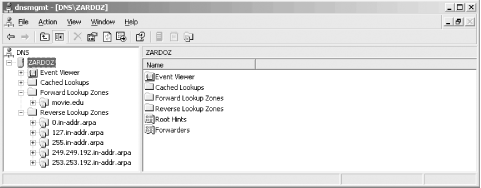Partial-Secondary Servers
In between a caching-only name server and a secondary name server is another variation: a name server that is a secondary for only a few of the local zones. We call this a partial-secondary name server (although probably nobody else does). Suppose movie.edu had 20/24-sized (the old Class C) networks (and a corresponding 20 in-addr.arpa zones). Instead of creating a secondary server for all 21 zones (all the in-addr.arpa subdomains plus movie.edu), we could create a partial-secondary server for movie.edu and only those in-addr.arpa zones the host itself is in. If the host had two network interfaces, its name server would be a secondary for three zones: movie.edu and the two in-addr.arpa zones.
Let’s say we scare up the hardware for another name server. We’ll call the new host zardoz.movie.edu, with IP addresses 192.249.249.9 and 192.253.253.9. We’ll create a partial-secondary name server on zardoz, with the configuration shown in Figure 9-5.
 |
This server is a secondary for movie.edu and only 2 of the 20 in-addr.arpa zones. A “full” secondary would have 20 different zones (plus the three automatically created) under Reverse Lookup Zones.
What’s so useful about a partial-secondary name server? They’re not much work to administer because their configuration doesn’t change much. On a server authoritative ...
Get DNS on Windows Server 2003, 3rd Edition now with the O’Reilly learning platform.
O’Reilly members experience books, live events, courses curated by job role, and more from O’Reilly and nearly 200 top publishers.

